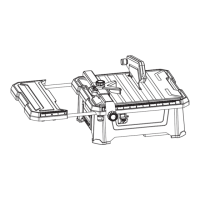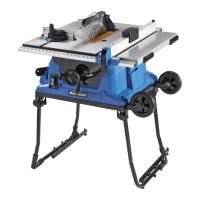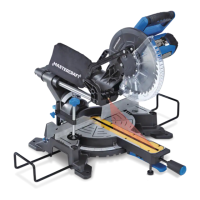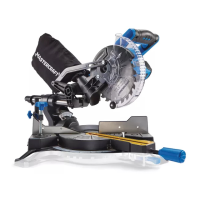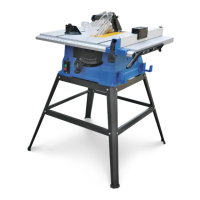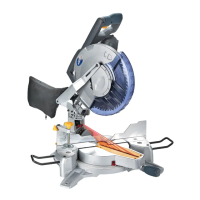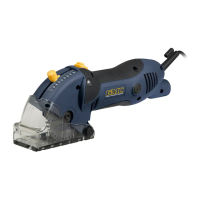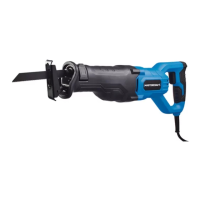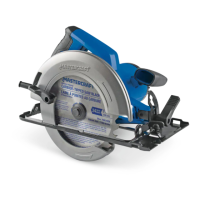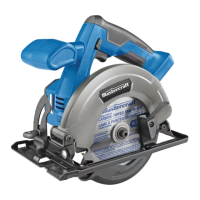WARNING!
Know your chop saw. Read the Owner’s Manual carefully. Learn the tool’s applications
and limitations, as well as the specific potential hazards related to this tool. Following
this rule will reduce the risk of electric shock, fire or serious injury.
DANGER!
Always unplug the tool from the power source before changing the cutting disc or when
cleaning the tool.
DANGER!
Never place your hands or fingers near the cutting disc while the tool is running. Severe
injury will result.
DANGER!
Never install a saw blade on this tool. It is designed ONLY for use with abrasive cut off
discs.
• Use this chop saw for cutting steel only. Cutting ceramic materials will create excessive dust and cause
damage to the motor.
• Always use a dust mask along with safety goggles when operating the chop saw.
• Always use hearing protection when operating the chop saw.
• Do not wear gloves, neckties or loose clothing.
• Do not cut material too small to be securely held in the vice.
• Always keep your hands out of the path of the abrasive wheel. Avoid awkward hand positions where a
sudden slip could cause your hand to move into the path of the abrasive wheel.
• Secure the workpiece. Use the clamping system provided with the chop saw. It is safer than using your
hand.
• Never hand hold a piece of material. Material will become very hot while being cut.
• Make sure there are no foreign objects in the part of the workpiece to be cut.
CAUTION!
In all cases, verify that the outlet in question is properly grounded. If you are not sure, have a
licensed electrician check the outlet.
9
SAFETY GUIDELINES
8
SAFETY GUIDELINES
• Inspect the tool for misalignment or binding of moving parts, broken parts, and any other condition that
may affect the operation of the tool. If it is damaged, have the tool serviced before using it. Many
accidents are caused by poorly maintained tools.
• Use only accessories that are recommended by the manufacturer for this model. Accessories that are
suitable for one tool may become hazardous when used with another tool.
SERVICE
• Tool servicing must be performed by qualified personnel. Service or maintenance performed by non-
qualified personnel could result in a risk of injury.
• When servicing a tool, use only identical replacement parts. Follow the instructions in the Maintenance
section of this manual. The use of unauthorized parts or failure to follow the instructions in the
Maintenance section of this manual may create a risk of electric shock or injury.
SPECIFIC SAFETY RULES
• Make sure the guard is installed and in proper working order before operating the chop saw.
• The abrasive wheel must be attached as described in this Owner’s Manual before connecting the tool to
the power source. Failure to do so will increase the risk of serious injury if the abrasive wheel shatters or
comes loose.
• Abrasive wheels must be stored in a dry location to prevent deterioration.
• Before attaching the abrasive wheel, inspect it for visible defects. If cracked, chipped or warped, do not
install it.
• Do not over tighten the clamp nut on the abrasive wheel. Excessive tightening may cause the disc to crack
and possibly shatter during operation.
• Before cutting, press the trigger switch and allow the abrasive wheel to reach full speed.
• Never turn the chop saw on with the abrasive wheel touching the work surface.
• Use only abrasive wheel that is rated for a speed 3300 RPM or greater.
• Do not use the chop saw if the clamping flanges or cap screw are missing or improperly installed.
• Dust and abrasive materials should not be allowed to build up in the workshop. Hot metal sparks could
start a fire.
• Do not remove the soft paper in the centre of the abrasive wheel.
• Do not alter or enlarge the centre hole of the abrasive wheel as this could result in the disc shattering.
USE SAFETY GOGGLES AND EAR PROTECTION
ALWAYS WEAR EYE PROTECTION THAT CONFORMS WITH CUL REQUIREMENTS. Flying
debris can cause permanent eye damage.
The tool is loud and the sound can cause hearing damage. Always wear ear protection to help
prevent hearing damage and loss. Failure to comply may result in moderate injury.
USE DUST MASK
Some dust created by sawing contains chemicals that are known to cause cancer, birth defects
or other reproductive harm. Some examples of these chemicals are: lead from lead-based paints;
crystalline silica from bricks, cement and other masonry products; or arsenic and chromium from
chemically-treated lumber. To reduce exposure to these chemicals, work in a well-ventilated
area with approved safety equipment, such as dust masks that are specially designed to filter out microscopic
particles.
ELECTRICAL SAFETY
GUIDELINES FOR USING EXTENSION CORDS:
In the event of a malfunction or breakdown, grounding provides a path of least resistance for electric current
model no. 055-4500-6 | contact us 1-800-689-9928

